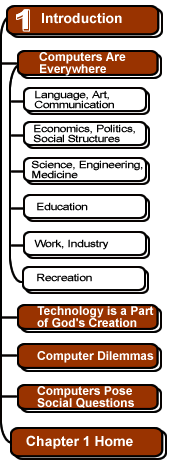

Computers in Language, Art, and Communication (continued)
Computers and Communication
Telecommunication
With the proliferation of computer networks in particular, computers
have transformed telecommunication systems.
A growing number of telephone systems (including cellular telephone systems) are now digital. Digital telephone answering systems record messages on memory chips instead of on cassette tapes. VoIP (Voice-over-Internet Protocol) services such as Webcams—digital cameras connected to computers that are linked to the Internet—enable the transmission of live pictures and video. When Internet phone technology and webcams are combined, videoconferencing is possible.
 Cable
television companies are moving to digital cable, and the
small satellite dishes used in digital satellite systems (DSS) seem
to sprout up on rooftops overnight. Services such as Tivo
and ReplayTV
record television programs on computer hard drives rather than on video
tape. Digital video cameras capture video in digital format and enable
video editing on a personal computer. Websites such as the video business.
Cable
television companies are moving to digital cable, and the
small satellite dishes used in digital satellite systems (DSS) seem
to sprout up on rooftops overnight. Services such as Tivo
and ReplayTV
record television programs on computer hard drives rather than on video
tape. Digital video cameras capture video in digital format and enable
video editing on a personal computer. Websites such as the video business.
Beginning in 1994 (and continuing each year since), computers have outsold televisions in the U.S.
Online
Communication
The inventors of what became the Internet did not even have
e-mail in mind when they developed the first computer
network, but e-mail quickly became the most popular feature of the Internet.
The @ symbol itself
has become a cultural icon: one is just as likely to glimpse it on city
buses, cereal boxes, and t-shirts as in an e-mail message.
 In
the past couple of years, the popularity of e-mail has been challenged
by the arrival of instant messaging technologies. Although
Internet chat systems have enjoyed varying degrees
of popularity since the late 1980s, IM has grown at
an explosive rate. IM technology gained widespread publicity when America
Online's IM service, "Instant Messenger," was featured in
the 1998 Warner Brothers film"You've
Got Mail," starring Meg Ryan and Tom Hanks.
In
the past couple of years, the popularity of e-mail has been challenged
by the arrival of instant messaging technologies. Although
Internet chat systems have enjoyed varying degrees
of popularity since the late 1980s, IM has grown at
an explosive rate. IM technology gained widespread publicity when America
Online's IM service, "Instant Messenger," was featured in
the 1998 Warner Brothers film"You've
Got Mail," starring Meg Ryan and Tom Hanks.
 Text messaging—the
sending of a small amount of text to appear on someone else's cell phone—is
eclipsing both e-mail and instant messaging in popularity.
Text messaging—the
sending of a small amount of text to appear on someone else's cell phone—is
eclipsing both e-mail and instant messaging in popularity.
These pages were written by Jeffrey L. Nyhoff and Steven H. VanderLeest
and edited by Nancy Zylstra
© 2005 Calvin University (formerly Calvin College), All Rights Reserved.
If you encounter technical errors, contact computing@calvin.edu.